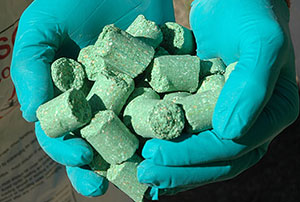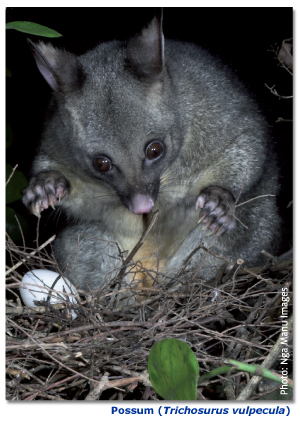1080 - Protecting our agriculture and biodiversity
Protecting our agriculture and biodiversity
1080 is an emotive topic. But Waikato Regional Council believes it's vital to protect our precious native forests and birds. And, in some places in our region, aerial 1080 operations are the only effective way to control their predators, such as possums, rats and stoats.
We've tried to provide you with as much information and assurance as we can, here, on the safety and benefits of using 1080.
What is 1080?
1080 (sodium monofluoroacetate) is a naturally occurring toxin found in plants in Australia, South America and South Africa. It’s thought to have developed to put animals off browsing.
As a pesticide, 1080 is manufactured synthetically in the United States of America. It breaks down harmlessly in water and soil. It’s poisonous to possums, which die humanely of heart or respiratory failure.

Are there any risks?
Many people are concerned about the use of 1080, especially about the health risks, and the effects on native birds.
Footnotes
1. Parliamentary Commissioner for the Environment. June 2011. Evaluating the use of 1080: Predators, poisons and silent forests. Wellington: 49. See http://www.pce.parliament.nz/assets/Uploads/PCE-1080.pdf
Why use 1080?
It's simple. We need to protect our forests, native birds and agriculture.
We target possums in particular, because they pose a major threat to the Waikato region's economy and environment.
- They carry bovine tuberculosis (Tb), a serious disease of cattle and deer.
- They eat eggs, chicks and even adult birds, and destroy habitat and food sources.
- They destroy forest areas, browsing trees and other plants to near extinction. They especially like to feed on young foliage, flowers and fruit, which prevents forest regeneration. They’re found in greater numbers in the native forest/pasture margin areas where there is plentiful browsing. We can easily see the results of possums in the death of our rata, kamahi and pohutukawa trees.
- Exotic forestry and ornamental plants are also heavily browsed.
1080 operations also significantly reduce the numbers of stoats, rats, ferrets, and other predators. You can find out more about the harm these predators have on our forests, native birds and agriculture in our pest pages.
Without effective pest animal control, we'll lose more of our forest and more native bird species will become extinct.
Monitoring shows no long-term negative effects on native bird populations from 1080.

Aerial 1080 drops
Waikato Regional Council manages large scale possum control programmes to maintain gains made under previous Animal Health Board control.
Waikato Regional Council and the Department of Conservation manage major possum control operations in the region, but landowners and occupiers are encouraged to take responsibility for controlling possums on their own land.
Our contractors mostly target possums by trapping and laying ground baits. However, in rugged, inaccessible areas where ground baiting is too difficult, we carry out a small number of carefully controlled aerial drops of 1080. This means about one teaspoon of 1080 per hectare is applied.
Our contractors use highly accurate GPS (global positioning systems) to keep the drops clear of water supplies, rivers, paddocks and other sensitive areas.
So how do people know?
Waikato Regional Council usually undertakes aerial 1080 possum control operations during winter months to achieve the best possum kills.
The approval of the Medical Officer of Health is required for all aerial 1080 operations. We consult with landowners in the area well before a drop is done. Target areas are also well signposted. Farmers are advised to make sure livestock are kept away from the target area.
Other pest control methods
Other pest control methods can be used. But they all have drawbacks, and none are as cost effective or efficient for reducing possum numbers in remote or rugged areas.
Recreational and commercial hunting generally cannot reduce possum numbers enough, especially in remote areas. When possum densities drop, commercial hunters move on to other high-density areas, so possum numbers are never reduced low enough for forests and bird life to recover and Tb to be eradicated.
Cyanide has killed kiwi and can kill people. 1080 hasn’t killed kiwi and no deaths have been recorded for humans.
Brodifacoum (Pestoff) is not water-soluble and takes three months to break down.
Traps have maimed and killed large numbers of weka and kiwi – even Timms traps.
Report from Parliamentary Commissioner for the Environment evaluation
In June 2011, the Parliamentary Commissioner for the Environment released a report investigating the use of 1080 – Evaluating the use of 1080: Predators, poisons and silent forests.
In the report Dr Wright recommends against a moratorium on 1080 citing the damage that would be done to native forests and animals if such a ban went ahead.
Questions and answers
Check out the publication produced by the National Pest Control Agencies. It answers commonly asked questions about:
- possums, TB and the implications for the New Zealand economy
- facts about 1080 – research covering its toxicity and effect on water and soils
- benefits of 1080 – case studies showing the benefits or possum control for native wildlife and successful TB control.



To ask for help or report a problem, contact us
Tell us how we can improve the information on this page. (optional)